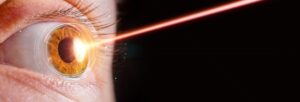
What is LASIK?
Lasik is eye surgery that is performed to correct refractive errors in vision (nearsightedness, farsightedness, and/or astigmatism). The eye surgeon uses either a microkeratome or a femtosecond laser to cut a thin flap in the cornea and peel it back to do the procedure. The underlying layer of cornea tissue is reshaped using another excimer laser and then the cornea flap is unfolded and the surgery is complete. The doctor uses local anesthesia in the form of eye drops and the surgery is usually finished in about 10 minutes.
Risk Factors
Cornea Shape- Since LASIK reshapes the cornea in order to correct or improve eyesight; candidates with too thin or irregular shaped corneas are at risk for poor results. The shape of the cornea affects how well the surgeon is able to correct the issue.
Large Pupils- Patients with large pupils are at risk for side effects when trying to see in the dark. In darkness, pupils dilate to take in as much light as possible but after LASIK if the patient has large pupils, the dilation area may be larger than the area of treatment. This can cause halos/starburst around sources of light. High Refractive Error- LASIK is performed to correct refractive error in a patient’s vision. But there is an increased risk of poor results when that error is considered too high. LASIK has a great track record when correcting vision with errors under a certain threshold.
Unstable Vision- When the vision of a patient changes significantly in the prior 12 months. Dry Eyes- If a patient is predisposed to having dry eyes, there is a significantly higher risk of suffering from dry eyes after surgery since LASIK temporarily hinders tear production. Dry eyes interfere with the healing process and affect the results of the procedure. Some other risk factors that influence LASIK are age, pregnancy and certain degenerative or active autoimmune disorders.
Complications and Side effects
Undercorrection/Overcorrection- Not enough/too much tissue of the cornea is removed, vision for the patient is not as clear as expected. An overcorrection is much harder to correct.
Returning to Pre-surgery Vision- Over time, vision of the patient may return to the original state. May result from abnormal healing, hormonal imbalances or pregnancy.
Vision Loss or Change- Rarely, a patient may experience loss of vision from complications or the patient may not see as clear or as well as before the surgery.
Astigmatism- Can be caused from uneven cornea tissue removal. May need another surgery, glasses or contacts to correct.
Glare, Halos and Double Vision- After surgery, patients may experience difficulty seeing at night, and experience glare or halos around bright lights or double vision.
Dry Eyes- LASIK temporarily causes decreased tear production. For the first 6 months, eyes may seem excessively dry.
Flap problems- Improper healing of the folding or removal of tissue flap can cause complications like infection, excess tears, and inflammation. While there are many risks and complications associated with LASIK surgery, doctors do a very thorough job of prescreening their patients, which drastically reduces the risks and complications. The success rate of patients achieving 20/20 vision after LASIK is right around 96% nationally. For additional information, you can contact one of our centers – LASIK Eye Surgery in Atlanta if you’re in Georgia.
Contact Us
If you have more questions about LASIK procedures, get in touch with us.
Related Blogs

Who Should Not Have Laser Eye Surgery
Laser eye surgery, commonly known as LASIK (Laser-Assisted In Situ Keratomileusis), has revolutionized the world of vision correction. It’s a procedure that has enabled millions

LASIK eye surgery: What is LASIK and how does it work?
What Is LASIK? Experts categorize LASIK as a refractive eye surgery in which lasers are used to correct vision problems. LASIK corrects several refractive errors,

Everything You Need To Know About The Lipiflow Treatment
LipiFlow is often referred to as a ground-breaking technology that is able to treat dry eye issues caused by meibomian gland dysfunction, or MGD. Experts
